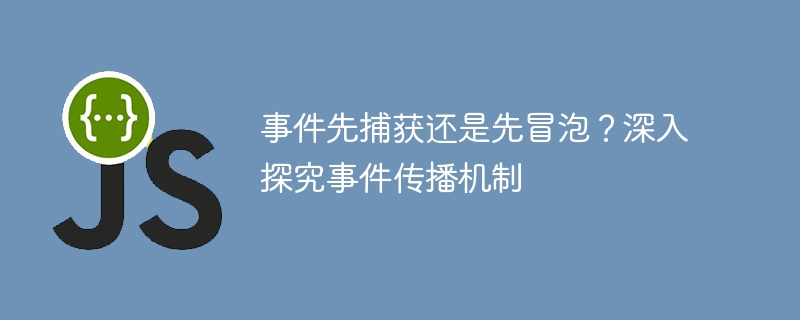Home >Web Front-end >JS Tutorial >Discuss the event propagation mechanism: capture first or bubble first?
Discuss the event propagation mechanism: capture first or bubble first?
- 王林Original
- 2024-02-18 23:52:271321browse

Events are captured first or bubbled first? In-depth exploration of the event propagation mechanism
The event propagation mechanism is a common concept in web development. When users perform operations in the browser, such as clicking buttons, scrolling pages, or entering text, these operations will trigger corresponding events. The event propagation mechanism determines how these events will be propagated to different elements in the HTML document and how they should be processed.
Before delving into the event propagation mechanism, let’s first understand event capture and event bubbling. During the event propagation process, the browser will pass the event from the top-level element to the target element, and trigger the corresponding event handler during the delivery process. Event capturing refers to the process of events passing from the top element all the way down to the target element, while event bubbling refers to the process of events bubbling up from the target element to the top element.
In early browsers, event propagation was carried out in the order of event capture -> target element -> event bubbling. However, with the development of browsers, W3C proposed a standard model for event propagation, that is, event capture -> target element -> event bubbling sequence. This standard model is supported by most major browsers.
In the process of event propagation, each element has a list of event handlers to store the event handling functions related to the element. When an event propagates to an element, the browser checks the element's event handler list and calls those event handlers in turn. If the event handling function returns false, the propagation of the event will stop and will not continue to be delivered. Otherwise, the event continues to propagate to the next element until it reaches the target element.
The order in which events are propagated is meaningful because it determines the order in which event handlers are executed. If an event is captured before bubbling, event handlers registered in the capture phase of the event will be executed before event handlers registered in the bubbling phase of the event. This means that if there is both an event capturing handler and an event bubbling handler on the target element, the event capturing handler will be executed first, and then the event bubbling handler will be executed.
The event propagation mechanism has many applications in actual Web development. For example, event delegation is a common technique that uses the event bubbling mechanism to bind event handlers to parent elements rather than to child elements. This allows you to use only one event handler when processing multiple child elements, reducing code complexity and redundancy.
In addition, the event propagation mechanism can also be used to resolve conflicts in events. When multiple elements have registered event handlers for the same event, if they all return false during the event bubbling phase, the propagation of the event will stop and will not continue to be passed to other elements, thus avoiding the need for event handlers to Repeat.
In actual development, we can also manually stop the propagation of events by calling the stopPropagation() method of the event object. This method immediately stops the propagation of the event and prevents event handlers on subsequent elements from being executed.
In summary, the event propagation mechanism is a very important concept in web development. Whether an event is captured first or bubbled first depends on the order of event propagation. According to W3C standards, the order of event propagation is to capture first and then bubble. Understanding the event propagation mechanism is critical to writing efficient event handlers and resolving event conflict issues. In actual development, rational use of the event propagation mechanism can simplify code logic and improve development efficiency.
The above is the detailed content of Discuss the event propagation mechanism: capture first or bubble first?. For more information, please follow other related articles on the PHP Chinese website!

